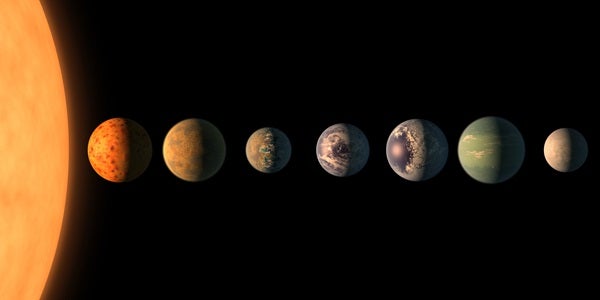It can be hard to visualize something you can’t see, so when NASA announced the TRAPPIST-1 system, they knew they needed to get some great artists to visually represent the amazing new system.
Robert Hurt, a visualization scientist at Caltech’s IPAC Center with a Ph.D. in astrophysics, and Tim Pyle, a multimedia producer with a background in Hollywood special effects, came together to create visualizations of the TRAPPIST-1 system.
The seven-planet system discovered by NASA’s Spitzer Space Telescope has three Earth-size planets in its habitable zone. As no telescope is powerful enough to photograph our distant neighbors yet, the two were tasked with creating realistic renderings of what they might look like.
“For the public, the value of this is not just giving them a picture of something somebody made up,” Douglas Hudgins, a program scientist for the Exoplanet Exploration Program at NASA Headquarters, said in a press release. “These are real, educated guesses of how something might look to human beings. An image is worth a thousand words.”
Hurt and Pyle worked with data from telescopes and consulted the discovery team at NASA as they went along. TRAPPIST-1b was inspired by Jupiter’s moon, Io. Pyle based the design of TRAPPIST-1h, the most distant and mysterious planet in the system, off two more of Jupiter’s moons, Ganymede and Europa.
“When we’re doing these artist’s concepts, we’re never saying, ‘This is what these planets actually look like,'” Pyle said. “We’re doing plausible illustrations of what they could look like, based on what we know so far. Having this wide range of seven planets actually let us illustrate almost the whole breadth of what would be plausible. This was going to be this incredible interstellar laboratory for what could happen on an Earth-sized planet.”
Based on the possibly that the planets are tidally locked, Hurt put an ice cap on TRAPPIST-1c’s dark side. Hurt also took a little creative liberty, putting water on the “dayside” of TRAPPIST-1d, one of the three habitable planets. Scientists originally wanted him to depict an “eyeball world,” where the side facing the host star would be hot and dry, the side on the back would be icy, and the middle would have water. But Hurt tried to convince them his design would be the best bet.
“Then I kind of pushed back, and said, ‘If it’s on the dark side, no one can look at it and understand we’re saying there’s water there,’” Hurt said.
After the disagreement, the team compromised, allowing water to be seen in the “dayside.”
Ultimately, the team’s main goal was to get the public excited about science and give them more information about what these planets might look like.










